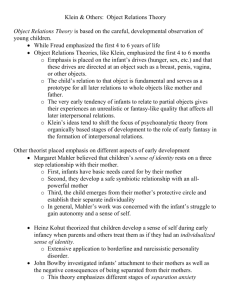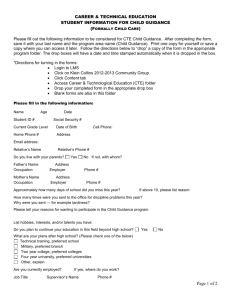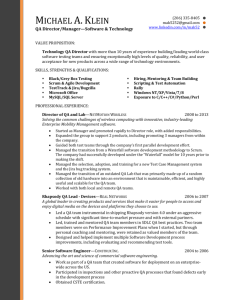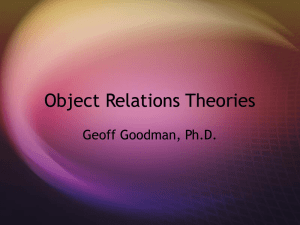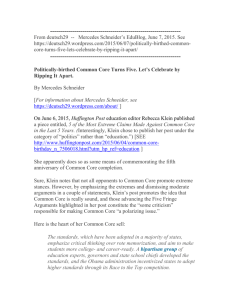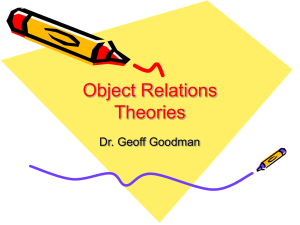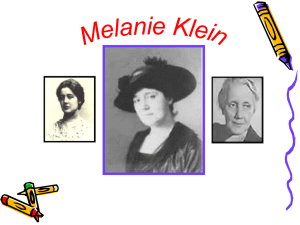GUIDE 5
advertisement
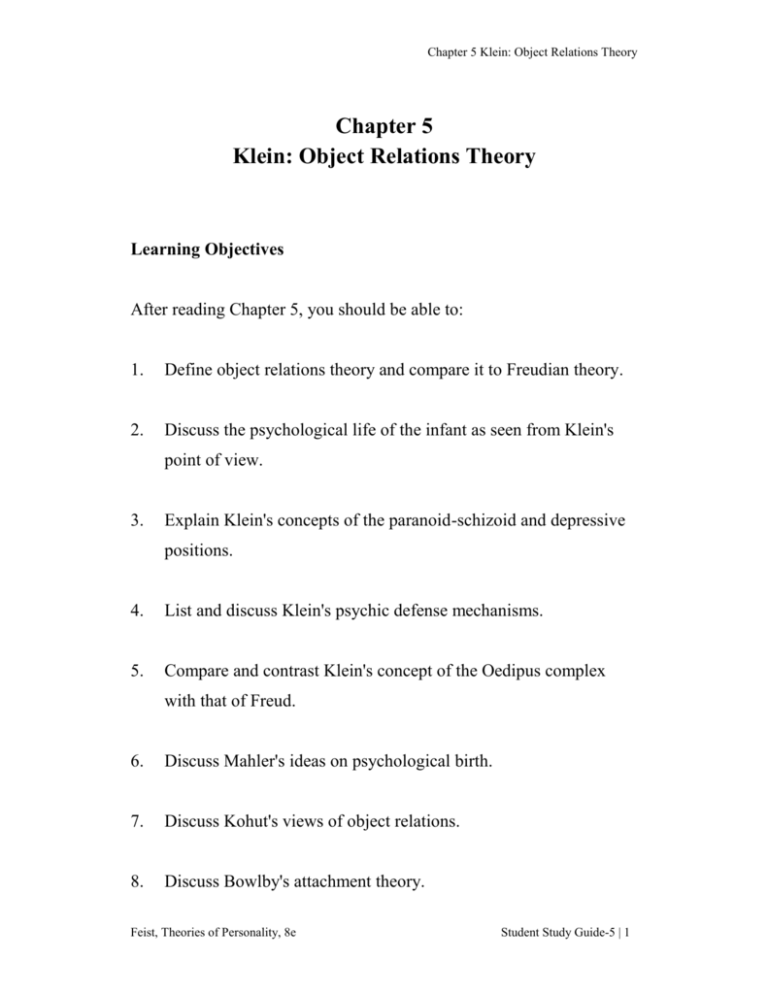
Chapter 5 Klein: Object Relations Theory Chapter 5 Klein: Object Relations Theory Learning Objectives After reading Chapter 5, you should be able to: 1. Define object relations theory and compare it to Freudian theory. 2. Discuss the psychological life of the infant as seen from Klein's point of view. 3. Explain Klein's concepts of the paranoid-schizoid and depressive positions. 4. List and discuss Klein's psychic defense mechanisms. 5. Compare and contrast Klein's concept of the Oedipus complex with that of Freud. 6. Discuss Mahler's ideas on psychological birth. 7. Discuss Kohut's views of object relations. 8. Discuss Bowlby's attachment theory. Feist, Theories of Personality, 8e Student Study Guide-5 | 1 Chapter 5 Klein: Object Relations Theory 9. Discuss Ainsworth's Strange Situation. Summary Outline I. Overview of Object Relations Theory Many personality theorists have accepted some of Freud's basic assumptions while rejecting others. One approach to extending psychodynamic theory has been the object relations theories of Melanie Klein and others. Unlike Jung and Adler who came to reject Freud's ideas, Klein tried to validate Freud's theories. In essence, Klein extended Freud's developmental stages downward to the first 4 to 6 months after birth. II. Biography of Melanie Klein Melanie Klein was born in Vienna in 1892, the youngest of four children. She had neither a PhD nor an MD degree but became an analyst by being psychoanalyzed. As an analyst, she specialized in working with young children. In 1927, she moved to London where she practiced until her death in 1960. III. Introduction to Object Relations Theory Object relations theory differs from Freudian theory in three important ways: (1) it places more emphasis on interpersonal relationships, (2) it stresses the infant's relationship with the mother rather than the father, and (3) it suggests that people are motivated primarily for human contact rather than for sexual pleasure. The term object in object relations theory refers to any Feist, Theories of Personality, 8e Student Study Guide-5 | 2 Chapter 5 Klein: Object Relations Theory person or part of a person that infants introject, or take into their psychic structure and then later project onto other people. IV. Psychic Life of the Infant Klein believed that infants begin life with an inherited predisposition to reduce the anxiety that they experience as a consequence of the clash between the life instinct and the death instinct. A. Fantasies Klein assumed that very young infants possess an active, unconscious fantasy life. Their most basic fantasies are images of the "good" breast and the "bad" breast. B. Objects Klein agreed with Freud that drives have an object, but she was more likely to emphasize the child's relationship with these objects (parents' face, hands, breast, penis, etc.), which she saw as having a life of their own within the child's fantasy world. V. Positions In their attempts to reduce the conflict produced by good and bad images, infants organize their experience into positions, or ways of dealing with both internal and external objects. A. Paranoid-Schizoid Position The struggles that infants experience with the good breast and the bad breast lead to two separate and opposing feelings—a desire to harbor the breast and a desire to bite or destroy it. To tolerate these two feelings, the ego splits itself by retaining parts of its life and death instincts while projecting other parts onto the Feist, Theories of Personality, 8e Student Study Guide-5 | 3 Chapter 5 Klein: Object Relations Theory breast. It then has a relationship with the ideal breast and the persecutory breast. To control this situation, infants adopt the paranoid-schizoid position, which is a tendency to see the world as having both destructive and omnipotent qualities. B. Depressive Position By depressive position, Klein meant the anxiety that infants experience around 6 months of age over losing their mother and yet, at the same time, wanting to destroy her. The depressive position is resolved when infants fantasize that they have made up for their previous transgressions against their mother and also realize that their mother will not abandon them. VI. Psychic Defense Mechanisms According to Klein, children adopt various psychic defense mechanisms to protect their egos against anxiety aroused by their own destructive fantasies. A. Introjection Klein defined introjection as the fantasy of taking into one's own body the images that one has of an external object, especially the mother's breast. Infants usually introject good objects as a protection against anxiety, but they also introject bad objects in order to gain control of them. B. Projection The fantasy that one's own feelings and impulses reside within another person is called projection. Children project both good and bad images, especially onto their parents. C. Splitting Feist, Theories of Personality, 8e Student Study Guide-5 | 4 Chapter 5 Klein: Object Relations Theory Infants tolerate good and bad aspects of themselves and of external objects by splitting, or mentally keeping apart, incompatible images. Splitting can be beneficial to both children and adults, because it allows them to like themselves while still recognizing some unlikable qualities. D. Projective Identification Projective identification is the psychic defense mechanism whereby infants split off unacceptable parts of themselves, project them onto another object, and finally introject them in an altered form. VII. Internalizations After introjecting external objects, infants organize them into a psychologically meaningful framework, a process that Klein called internalization. A. Ego Internalizations are aided by the early ego's ability to feel anxiety, to use defense mechanisms, and to form object relations in both fantasy and reality. However, a unified ego emerges only after first splitting itself into the two parts—those that deal with the life instinct and those that relate to the death instinct. B. Superego Klein believed that the superego emerged much earlier than Freud had held. To her, the superego preceded rather than followed the Oedipus complex. Klein also saw the superego as being quite harsh and cruel. C. Oedipus Complex Feist, Theories of Personality, 8e Student Study Guide-5 | 5 Chapter 5 Klein: Object Relations Theory Klein believed that the Oedipus complex begins during the first few months of life, then reaches its zenith during the genital stage, at about 3 or 4 years of age—the same time that Freud had suggested it began. Klein also believed that much of the Oedipus complex is based on children's fear that their parents will seek revenge against them for their fantasy of emptying the parent's body. For healthy development during the Oedipal years, children should retain positive feelings for each parent. According to Klein, the little boy adopts a "feminine" position very early in life and has no fear of being castrated as punishment for his sexual feelings toward his mother. Later, he projects his destructive drive onto his father, whom he fears will bite or castrate him. The male Oedipus complex is resolved when the boy establishes good relations with both parents. The little girl also adopts a "feminine" position toward both parents quite early in life. She has a positive feeling for both her mother's breast and her father's penis, which she believes will feed her with babies. Sometimes the girl develops hostility toward her mother, whom she fears will retaliate against her and rob her of her babies, but in most cases, the female Oedipus complex is resolved without any jealousy toward the mother. VIII. Later Views of Object Relations A number of other theorists have expanded and altered Klein's theory of object relations. Notable among them are Margaret Mahler, Heinz Kohut, John Bowlby. and Mary Ainsworth. A. Margaret Mahler's View Feist, Theories of Personality, 8e Student Study Guide-5 | 6 Chapter 5 Klein: Object Relations Theory Mahler, a native of Hungary who practiced psychoanalysis in both Vienna and New York, developed her theory of object relations from careful observations of infants as they bonded with their mothers during their first 3 years of life. In their progress toward achieving a sense of identity, children pass through a series of three major developmental stages. First is normal autism, which covers the first 3 to 4 weeks of life, a time when infants satisfy their needs within the all-powerful protective orbit of their mother's care. Second is normal symbiosis, when infants behave as if they and their mother were an omnipotent, symbiotic unit. Third is separationindividuation, from about 4 months until about 3 years, a time when children are becoming psychologically separated from their mothers and achieving individuation, or a sense of personal identity. B. Heinz Kohut's View Kohut was a native of Vienna who spent most of his professional life in the United States. More than any of the other object relations theorists, Kohut emphasized the development of the self. In caring for their physical and psychological needs, adults treat infants as if they had a sense of self. The parents' behaviors and attitudes eventually help children form a sense of self that gives unity and consistency to their experiences. C. John Bowlby's Attachment Theory Bowlby, a native of England, received training in child psychiatry from Melanie Klein. By studying human and other Feist, Theories of Personality, 8e Student Study Guide-5 | 7 Chapter 5 Klein: Object Relations Theory primate infants, Bowlby observed three stages of separation anxiety: (1) protest, (2) apathy and despair, and (3) emotional detachment from people, including the primary caregiver. Children who reach the third stage of separation anxiety lack warmth and emotion in their later relationships. D. Mary Ainsworth and the Strange Situation Mary Ainsworth was born in Ohio in 1919 and died in 1999. She and her colleagues developed a technique called the Strange Situation for measuring one of three the types of attachment styles—secure attachment, anxious-resistant attachment, and anxious-avoidant attachment. IX. Psychotherapy The goal of Klein's therapy was to reduce depressive anxieties and persecutory fears and to lessen the harshness of internalized objects. To do this, Klein encouraged patients to reexperience early fantasies and pointed out the differences between conscious and unconscious wishes. X. Related Research Research on object relations has included a variety of topics, including eating disorders and adult relationships. One study of both topics was conducted by Smolak and Levine (1993) who found that bulimia was associated with detachment from parents, whereas anorexia was associated with high levels of guilt and conflict over separation from parents. More recently, Steven Huprich and colleges (Huprich, Stepp, Graham, & Johnson, 2004) found that both men and women who were insecurely attached Feist, Theories of Personality, 8e Student Study Guide-5 | 8 Chapter 5 Klein: Object Relations Theory and self-focused (egocentric) had greater difficulty in controlling their compulsive eating than did those who were more securely attached and less self-focused. Attachment theory was originally conceptualized by John Bowlby, who emphasized the relationship between parent and child. Since the 1980s, researchers have begun to examine systematically the attachment relationships in adults, especially in romantic relationships. The usefulness of attachment theory was investigated in a classic study by Cindy Hazan and Phil Shaver (1987). These researchers found that people with secure early attachments experienced more trust, closeness, and positive emotions in their adult love relationships than did other people. Steven Rholes and colleagues found that as they predicted, avoidant individuals do not seek out additional information about their romantic partners’ intimate feelings and dreams, and anxious individuals seek more information about their partners’ intimacy-related issues and goals for the future (Rholes, Simpson, Tran, Martin, & Friedman, 2007). Rivka Davidovitz and others also examined attachment style in leaderfollower relationships, specifically military officers and their soldiers (Davidovitz, Mikulincer, Shaver, Izsak, & Popper, 2007; Popper & Mayseless, 2003). They found units with officers who had an avoidant attachment style to be less cohesive, and their soldiers reported lower psychological well-being than members of other units. Anxiously attached officers’ units rated low on instrumental functioning, but high on socioemotional functioning. Feist, Theories of Personality, 8e Student Study Guide-5 | 9 Chapter 5 Klein: Object Relations Theory Recent research shows that attachment theory is important to understanding a wide range of adult relationships. XI. Critique of Object Relations Theory Object relations theory shares with Freudian theory an inability to be either falsified or verified through empirical research. Nevertheless, some clinicians regard the theory as being a useful guide to action and as possessing substantial internal consistency. However, the theory must be rated low on parsimony and also low on its ability to organize knowledge and to generate research. XII. Concept of Humanity Object relations theorists see personality as being a product of the early mother-child relationship, and thus they stress determinism over free choice. The powerful influence of early childhood also gives these theories a low rating on uniqueness, a very high rating on social influences, and high ratings on causality and unconscious forces. Klein and other object relations theorists rate average on optimism versus pessimism. Test Items Fill-in-the-Blanks Feist, Theories of Personality, 8e Student Study Guide-5 | 10 Chapter 5 Klein: Object Relations Theory 1. Klein believed that the infant's relationship to the __________________ served as a model for later object relationships. 2. Object relations theory is an offspring of _________________ instinct theory. 3. According to Klein, __________________ are psychic representations of unconscious id instincts. 4. Infants ___________________, or take external objects, into their psychic structure. 5. An infant adopts the __________________________ position to fight off feelings of persecution. 6. Klein's _____________________ position consists of feelings of anxiety over losing a loved object combined with a sense of guilt for desiring to destroy that object. 7. With the psychic defense mechanism of ___________________, infants attempt to manage the good and bad aspects of themselves by keeping apart incompatible impulses. 8. With __________________ identification, infants split off unacceptable parts of themselves, project these parts onto another Feist, Theories of Personality, 8e Student Study Guide-5 | 11 Chapter 5 Klein: Object Relations Theory object, and then introject these parts back into themselves in a changed form. 9. Although the ____________________ is poorly organized at birth, it is strong enough to feel anxiety and to use defense mechanisms. 10. A little boy's ______________________ position is marked by a passive homosexual attitude toward his father. 11. During female oedipal development, a girl fears that her ___________ will injure her and take away her babies. 12. Mahler emphasized the psychological ________________ of the infant. 13. Kohut emphasized the evolution of the ______________________ from a vague image to a clear sense of individual identity. 14. The ________________ stage is the first stage of separation anxiety, as viewed by Bowlby. 15. The theorist who used the Strange Situation to show the parent/infant relationship was _________________. Feist, Theories of Personality, 8e Student Study Guide-5 | 12 Chapter 5 Klein: Object Relations Theory True-False _____1. Klein enjoyed a warm relationship with her daughter Melitta. _____2. In contrast to Freud’s, most of Klein’s patients were children. _____3. In comparison to Freudian theory, object relations theory places more importance on interpersonal relations. _____4. Object relations theory emphasizes the father-child relationship over the mother-child relationship. _____5. Throughout her life, Klein regarded herself as a Freudian, even though she had strong disagreements with Anna Freud. _____6. Klein rejected the idea of a death instinct. _____7. The paranoid-schizoid position is limited to infants. _____8. In theory, the superego is an internalization. _____9. During the early oedipal months, both boys and girls adopt a "feminine" position. ____10. Mahler's first major developmental stage was normal autism. Feist, Theories of Personality, 8e Student Study Guide-5 | 13 Chapter 5 Klein: Object Relations Theory ____11. During normal symbiosis, infants behave as if they and their mother were a unified, omnipotent system. ____12. Mahler's separation-individuation stage takes place from about the 4th or 6th year of life. ____13. A weakness of Mahler's theory is that it is based on observations of neurotic adults. ____14. Kohut believed that infants are naturally narcissistic. ____15. According to Kohut, innate instinctual drives are the core of human personality. ____16. Bowlby's first stage of attachment theory is despair. ____17. During Bowlby's third stage of separation anxiety, the infant becomes reattached to its mother. ____18. Ainsworth was influenced more by Bowlby than by Klein. ____19. Ainsworth found that secure infants will initiate contact with their mother immediately when their mother returns following a brief period of separation. Feist, Theories of Personality, 8e Student Study Guide-5 | 14 Chapter 5 Klein: Object Relations Theory ____20. Compared with secure infants, insecure infants lack the ability to engage in effective play. Multiple Choice ______1. Klein suggested that the infant's first model for interpersonal relations was a. the mother's breast. b. the father. c. the self. d. an imaginary playmate. ______2. One person psychoanalyzed by Melanie Klein was a. Erik Erikson. b. Erich Fromm. c. Anna Freud. d. Little Hans. e. her son Erich. _____3. Klein had a bitter rivalry with a. Sigmund Freud. b. Anna Freud. c. her daughter Melitta. d. all of these. e. none of these. Feist, Theories of Personality, 8e Student Study Guide-5 | 15 Chapter 5 Klein: Object Relations Theory _____4. Compared with Freudian theory, object relations theory a. places more emphasis on sexual pleasure. b. places more emphasis on interpersonal relations. c. stresses the importance of the father. d. emphasizes the id. ______5. The person or part of a person that satisfies the aim of an instinct is called a. the impetus. b. the source. c. the object. d. the unconscious motivator. _____6. Like Freud, Klein believed that people are motivated by a. the need for self-actualization. b. the need for homeostasis. c. the death instinct. d. separation anxiety. ______7. Klein's two basic psychological positions are a. the ideal and the real. b. the mature and the immature. c. the ego and the superego. d. the paranoid-schizoid and the depressive. e. introjection and projection. Feist, Theories of Personality, 8e Student Study Guide-5 | 16 Chapter 5 Klein: Object Relations Theory ______8. In order to control the good breast and to fight off its persecutors, infants use a. their superego. b. their id. c. the paranoid-schizoid position. d. the depressive position. _____9. Klein believed that feelings of anxiety about losing a loved object and a sense of guilt for desiring to destroy that object were part of a. the paranoid-schizoid position. b. the depressive position. c. moralistic anxiety. d. idealistic anxiety. ____10. Klein's psychic defense mechanisms a. protect the child against public disgrace. b. defend the ego and superego against the id. c. protect the ego against anxiety aroused by destructive fantasies. d. prevent unconscious fantasies from reaching consciousness. ____11. Infants use this means of controlling good and bad aspects of themselves. a. the paranoid-schizophrenic position Feist, Theories of Personality, 8e Student Study Guide-5 | 17 Chapter 5 Klein: Object Relations Theory b. the depressive position c. projection d. sublimation e. splitting ____12. Compared to Freud, Klein believed that the superego a. is much more harsh and cruel. b. emerged much later. c. grew out of the Oedipus complex. d. preceded the development of the id. ____13. Klein believed that at the end of a successfully resolved Oedipus complex, a girl will a. see her mother as a rival. b. develop positive feelings toward both parents. c. fantasize robbing her mother of her babies. d. adopt a homosexual attitude toward her mother. e. develop negative feelings toward her mother and neutral feelings for her father. ____14. Klein believed that a girl fantasizes that her father's penis feeds the mother with babies during this period. a. separation anxiety b. preadolescent c. introjective identification d. oedipal Feist, Theories of Personality, 8e Student Study Guide-5 | 18 Chapter 5 Klein: Object Relations Theory ____15. This object relations theorist spent much time observing normal babies as they bonded with their mothers during the first 3 years of life. a. Margaret Mahler b. Melanie Klein c. Heinz Kohut d. Mary Ainsworth ____16. Mahler's principal concern was with a. the effects of the superego on a child's development of morality. b. the psychological birth of the child. c. the child's neurotic-symbiotic relationship with its mother. d. the narcissistic needs of the child. ____17. During the separation-individuation stage, Mahler said, children begin to a. develop feelings of personal identity. b. despair of reuniting with the mother. c. develop normal autism. d. blame their mother for weaning them. ____18. Kohut was most interested in the a. physiological needs of infants. b. effects of the Oedipus complex. Feist, Theories of Personality, 8e Student Study Guide-5 | 19 Chapter 5 Klein: Object Relations Theory c. process by which the self evolves d. acquisition of language and its role in higher mental processes. ____19. According to Kohut, the needs to exhibit the grandiose self and the idealized parent image are called a. masochistic needs. b. sadistic needs. c. self-esteem needs. d. narcissistic needs. ____20. Bowlby's theory assumes that a. psychologically healthy infants have emotionally detached mothers. b. infants who are loved too much by their mother will have difficulty forming adult relationships. c. the mother-child bonding becomes a model for the child's future friendships. d. all of these. ____21. According to Bowlby, protest is the first stage of a. the oedipal period. b. identity. c. separation anxiety. d. the anal period. Feist, Theories of Personality, 8e Student Study Guide-5 | 20 Chapter 5 Klein: Object Relations Theory ____22. Ainsworth found that secure infants will a. strongly protest when their mother leaves the room. b. approach their mother when she returns to the room. c. grow up to have great difficulty with interpersonal relationships. d. relate more positively to their father than to their mother. Short Answer 1. Discuss similarities and differences between object relations theory and Freudian theory. 2. Discuss the role of phantasies in Klein's theory. Feist, Theories of Personality, 8e Student Study Guide-5 | 21 Chapter 5 Klein: Object Relations Theory 3. Name and explain Klein's four psychic defense mechanisms. 4. Discuss Klein's view of the male and female Oedipus complexes. 5. List and discuss Mahler's three developmental stages. Feist, Theories of Personality, 8e Student Study Guide-5 | 22 Chapter 5 Klein: Object Relations Theory 6. Discuss Kohut's views of object relations. 7. List and discuss the stages of Bowlby's attachment theory. 8. Describe Ainsworth's Strange Situation. Feist, Theories of Personality, 8e Student Study Guide-5 | 23 Chapter 5 Klein: Object Relations Theory Answers Fill-in-the-Blanks True-False Multiple Choice 1. breast 1. F 1. a 2. Freud's 2. T 2. e 3. phantasies 3. T 3. c 4. introject 4. F 4. b 5. paranoid-schizoid 5. T 5. c 6. depressive 6. F 6. c 7. splitting 7. F 7. d 8. projective 8. T 8. c 9. ego 9. T 9. b 10. feminine 10. T 10. c 11. mother 11. T 11. e 12. birth 12. F 12. a 13. self 13. F 13. b 14. protest 14. F 14. d 15. Ainsworth 15. T 15. a 16. T 16. b 17. F 17. a 18. T 18. c 19. T 19. a 20. T 20 c 21. d 22. b Feist, Theories of Personality, 8e Student Study Guide-5 | 24
